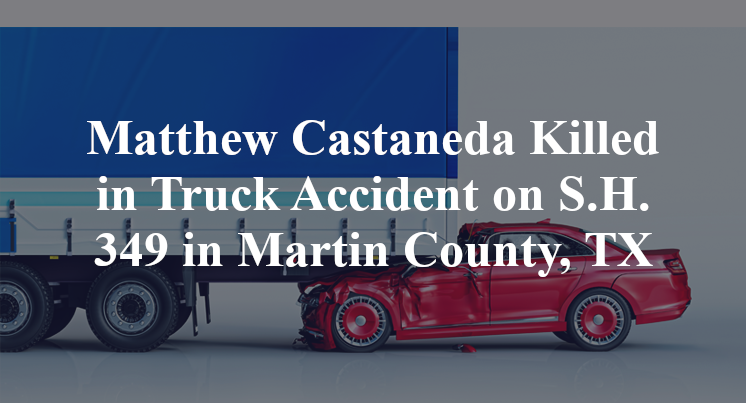Matthew Castaneda Killed in Truck Accident on S.H. 349 in Martin County, TX
Martin County, TX — February 10, 2025, Matthew Castaneda was killed following a truck accident at approximately 4:15 p.m. along State Highway 349.
According to authorities, Matthew Castaneda was traveling in a northbound Nissan pickup truck on S.H. 349 approaching the County Road 2051 intersection when the accident took place.

The cause of the accident remains unclear. Officials indicate that, for as yet unknown reasons, the Nissan collided with the rear-end of a northbound 18-wheeler that had been at a stop in the inside lane of the highway awaiting oncoming traffic to clear so it could make a left turn onto C.R. 2051.
Castaneda suffered fatal injuries over the course of the accident, according to reports, and was declared deceased at the scene. It does not appear that anyone else was hurt. Additional details pertaining to this incident are not available at this point in time. The investigation is currently ongoing.
Commentary by Attorney Michael Grossman
When a vehicle collides with the back of a stopped 18-wheeler on a highway, the key question isn’t just what happened, but why it happened. In my experience handling truck accident cases, rear-end crashes involving commercial trucks often have multiple contributing factors that need to be examined.
Was the stopped truck clearly visible to approaching drivers? An 18-wheeler waiting to turn left in an active travel lane can be difficult to see, especially if its brake lights or hazard signals aren’t functioning properly. Investigators should review maintenance records and post-crash inspections to determine whether the truck had proper lighting and reflectors.
Did the driver of the Nissan have enough time to react? Highways typically have higher speeds, which means drivers need sufficient warning to recognize and react to stopped vehicles. Was the driver distracted or impaired, or did road conditions affect visibility? Investigators should review phone records, potential toxicology reports, and weather conditions at the time of the crash.
Was the truck positioned safely? While waiting for oncoming traffic to clear, trucks should ensure they are as visible as possible to other drivers. Investigators should determine whether the truck driver followed proper procedures, such as using turn signals well in advance or positioning the vehicle in a way that minimized the risk of a rear-end collision.
Did broader issues contribute to the wreck? Trucking companies are responsible for ensuring their vehicles are properly maintained and that their drivers are trained to handle left turns safely on highways. If a company failed to enforce safety procedures or allowed a truck with poor visibility onto the road, those factors could have played a role in the crash. Investigators should review company policies, driver training records, and past safety violations to determine whether broader issues contributed to the wreck.
At the end of the day, the most important thing is finding answers. Even if it takes an independent investigation to gather the right evidence, it’s critical to examine every factor to ensure those affected by the crash get the clarity and closure they deserve.

“These are essential reads for anyone dealing with the aftermath of a truck wreck”– Attorney Cory Carlson